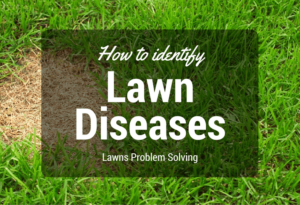Will it ever quit raining? May 2018 to April 2019 ranks as the wettest in history. As a result, we are seeing lawn disease everywhere, even in healthy lawns. When lawns cannot dry out between rainfall you will see fungus form and spread. This is what is happening in the Indianapolis area right now.
You can’t control what the environment does, but you can identify lawn disease when it first appears and stop it before there is significant damage to your turf. Spotting lawn diseases early can be the difference between saving your lawn or having it extensively damaged. Many lawn diseases are fast-moving and highly destructive. One day you notice some slight discoloration and by the end of the week, large areas of your lawn have been lost to the disease. Properly identifying lawn diseases in Central Indiana lawns can be tough. Some of these diseases look a lot alike and the triggers, which are mainly environmental, are similar.
How to Identify Lawn Disease
In order for lawn diseases to strike, three factors must be in play: disease pathogens, weather conditions that favor their development, and susceptible lawn grasses. Without all three, grasses keep the upper hand. While you can’t control the weather, you can recognize fungal threats and act. We don’t expect you to understand every turf disease out there. But knowing some of the common symptoms can help you spot a lawn disease early and call in the experts for help. Many of the different lawn diseases have overlapping or similar symptoms so even a basic understanding of potential problems will help you to know when things are awry.
 Common Signs of Lawn Disease
Common Signs of Lawn Disease
• Spots or lesions on grass blades
• Small, repetitive spots throughout turf areas
• Irregularly-shaped patches of discoloration throughout the lawn
• Web fungal structures (seen easily when there is dew in the morning)
• A powdery substance on the lawn
There are many lawn diseases out there but certainly, some are more common in our area than others. Some of the most common lawn diseases in our area include Dollar Spot, Red Thread, Leaf Spot, Brown Patch, Summer Patch, and Pythium Blight. The symptoms of these diseases can sometimes overlap and they are often confused from one another. We are currently seeing Dollar Spot and Red Thread in the Carmel, Indiana area lawns. We have listed common signs of this fungus:
Dollar Spot
• Silver-dollar-size circles spread up to 6 inches wide and eventually merge into large, irregular blocks.
• Grass develops straw-yellow spots that look water-soaked. Morning light reveals cobweb-like growth.
• Late spring through fall, mild-to-warm temperatures support disease development.
• Under-fertilizing, excessive moisture, drought stress and thatch leave grasses susceptible.
Red Thread
• Red or bleached-looking patches appear as grass blades wither from the tips.
• Reddish-pink threads bind blades together; red spores show up on shoes, mowers and tools.
• Mild, early spring temperatures and cool, wet conditions favor the disease.
• Under-fertilizing, high humidity, poor air circulation, shade, thatch, leaves wet for an extended period of time, and compacted soil contribute.
Treatment for Lawn Disease
At GreenLawn by Design, we want you to call us as soon as you spot a problem rather than wait it out. If we do determine that fungal treatment is needed, we can get started right away. A common dilemma you may face is deciding whether it’s worth the investment in multiple fungicide treatments throughout the summer in order to be fully protected—or whether you should just repair the damaged areas. It’s ultimately a judgment call that we can help you make. Some diseases will go away on their own if the lawn is well-maintained and given proper care. Sometimes just the conditions changing is enough to help disease clear when coupled with good lawn care.
However, if the disease is widespread and threatening to damage a large portion of your lawn, it may be time to treat your yard with a fungicide. Lawn fungicides work by stopping growth and therefore preventing further damage. However, they cannot fix the damage that already occurred. Damage can be addressed with recovery techniques in the fall, such as seeding and aeration. Fungicides are typically effective for about 21 days and then need to be reapplied again.
While you might be tempted to handle lawn disease control on your own, we would advise strongly against it. Though there are products at the big box stores to handle disease, it really does take an understanding of the disease specifics to know which product will work best on the specific disease your lawn is facing. As we mentioned, a lot of disease symptoms overlap and making a proper lawn disease diagnosis really does require a professional eye. If you do try to treat the disease yourself and do it incorrectly, it could be wasted money with no results.
While there is no surefire way to prevent disease from ever creeping in, handling it quickly will make all the difference in the world. At GreenLawn by Design, we cannot stress enough how important it is to get in touch with us quickly if you spot trouble.
If you think you are seeing signs of disease in your lawn, we recommend calling the experts at GreenLawn by Design so you can enjoy your plush, green lawn this summer. After all, an ugly, brown and rough terrain can’t compare to the luscious, emerald green lawn you plant your bare feet on after a long, busy day of summertime fun.
We value communication with our clients and view the best possible lawn care as a two-way street in which the client is regularly communicating with us and we’re regularly communicating with them. It is this ongoing partnership that will ensure a lawn disease diagnosis is made early and in time to be treated when necessary. Our goal is to provide the best possible lawn care and we can’t do that without your help. GreenLawn by Design will design a tailored approach to give your lawn exactly what it needs at exactly the right time. Fungicides are essential tools for suppressing infectious diseases and maintaining high quality turf. Contact us or call 317.804.8088 to learn more.


